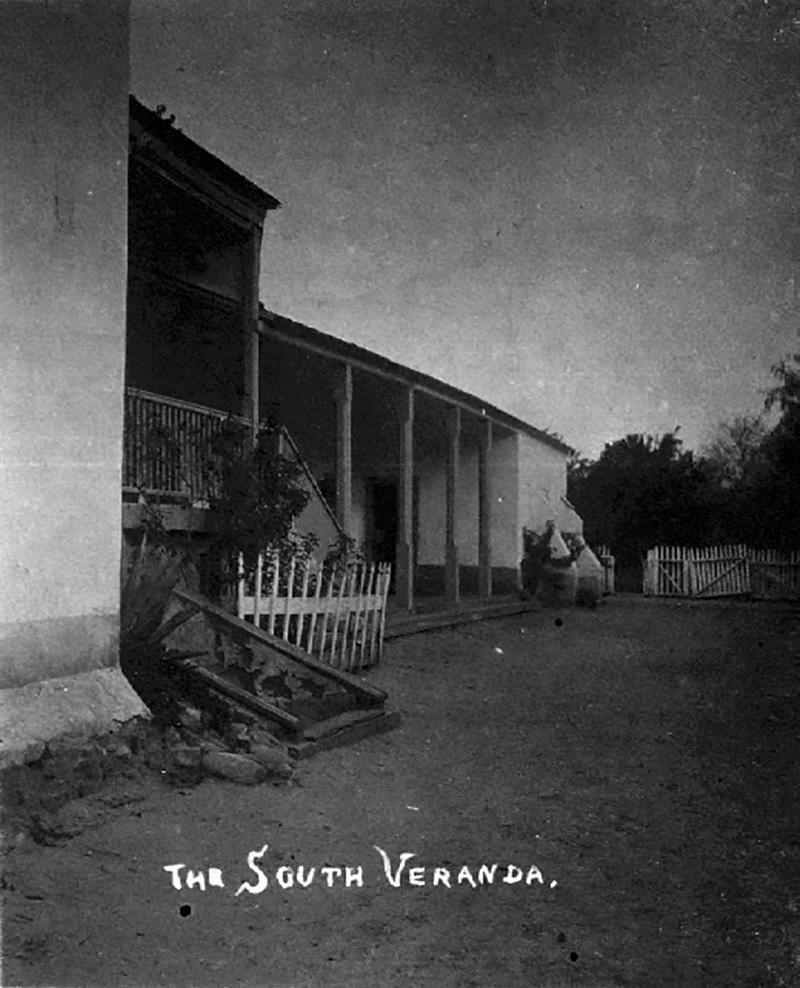|
|
Rancho Camulos Photos by Charles F. Lummis

Those who believe the characters in Helen Hunt Jackson's 1884 novel "Ramona" are based on the Del Valle family of Rancho Camulos would say that the south veranda's upper porch, seen here at left of center, is where the story's Señor Felipe, ill of the fever, lay on the pallet of hide that Alessandro made for him. From page 10 of The Home of Ramona: Photographs of Camulos, the fine old Spanish Estate Described by Mrs. Helen Hunt Jackson as the Home of "Ramona." This book was published in 1888 by Charles Flecher Lummis, then city editor of the Los Angeles Times and later founder of the Southwest Museum, to demonstrate that the Del Valle family's Rancho Camulos, located just east of Piru along what is now State Route 126, was indeed the inspiration for Jackson's romantic tome, Ramona. In photographs and text, Lummis showed the similarities between the rancho's chapel, courtyard, adobe home, etc. and those described by Jackson, who had died the same year she completed her novel, in 1884. Lummis writes of Jackson's Ramona: "No novel of strong purpose can be pure fiction. If it is to mould fact, it must deal with fact." But the case for Camulos as the "Ramona home" was in dispute. Cave Couts Jr., a slaveholder from Tennessee who arrived in 1851 and used Indian slave labor at his Rancho Guajome in San Diego County (Akins & Bauer 2021:141-142), argued that his ranch served as the inspiration for the book. Indeed, Jackson, of Colorado, visited both places prior to its completion — Camulos during a trek through California in 1882, and San Diego in 1882 and 1883. Couts — whose presence incidentally was felt in the Santa Clarita Valley at one time or another — ultimately gave up on his claim (others would pick it up later), at least partly because of the efforts of the Del Valles and their associates, like Lummis, to boost Camulos. Lummis, who engaged in countless extramarital affairs throughout his life, fell in what may have been true love with 17-year-old Susana Carmen del Valle, a cousin of then-patriarch Reginaldo and Belle del Valle, and while the family forebade a wedding (for one thing, Lummis was married), he remained a frequent visitor to the ranch. It is unknown (and doubtful) if they consummated the relationship. To lure tourists the Del Valles promoted Camulos as the legendary "Home of Ramona" on wine labels and on letterhead; and the Southern Pacific Railroad Co., embroiled in a rate war, touted a Camulos stop as the place Jackson took for the book's setting. Today, Ramona is most popularly remembered with an annual play in Hemet. Modern scholars generally agree that Jackson's story was not necessarily intended to be linked to any one place, and that by writing the novel, Jackson, the quintessential contemporary promoter and chronicler of the plight of American Indians, may have done more to fuel the mystique and allure of the West than anyone who had gone before. And by publishing his little book, Lummis has left for modern seekers of Camulos and Del Valle family history a lasting legacy.
HS3016: 9600 dpi jpeg from smaller jpeg from book, scanned May 29, 1998. |
• C. Rasmussen Story
Ygnacio Family Tree
Ygnacio 1808-1880
Family History: Del Castillo 1980
Del Valle Branding Iron, RSF 1830s-40s x5
Livestock Ledger 1853
History of Ownership
Wolfskill Foreclosure 1864
Labor Records
1919-1924
Ygnacio's L.A. Property 1871
Envelope: Reginaldo to Ysabel 1877–1883
James Walker Art
(1818-1889)
Ygnacio Bio 1889
Ysabel 1837-1905
Description 1879
Bedroom ~1890
Reginaldo Nominated Lt.Gov. 1890
Pico Oil Connection
Probate Filing, Death of Juventino, 1919
Reginaldo 1854/1938
Reginaldo Bio 1889
Lucretia 1892/1972 (Multiple Entries)
Nor. Cal. Basket mid-1800s
Bell, Portrait Come Home 10/28/2017
Reginaldo Recognized at UCLA 5/24/2019
|
The site owner makes no assertions as to ownership of any original copyrights to digitized images. However, these images are intended for Personal or Research use only. Any other kind of use, including but not limited to commercial or scholarly publication in any medium or format, public exhibition, or use online or in a web site, may be subject to additional restrictions including but not limited to the copyrights held by parties other than the site owner. USERS ARE SOLELY RESPONSIBLE for determining the existence of such rights and for obtaining any permissions and/or paying associated fees necessary for the proposed use.






















